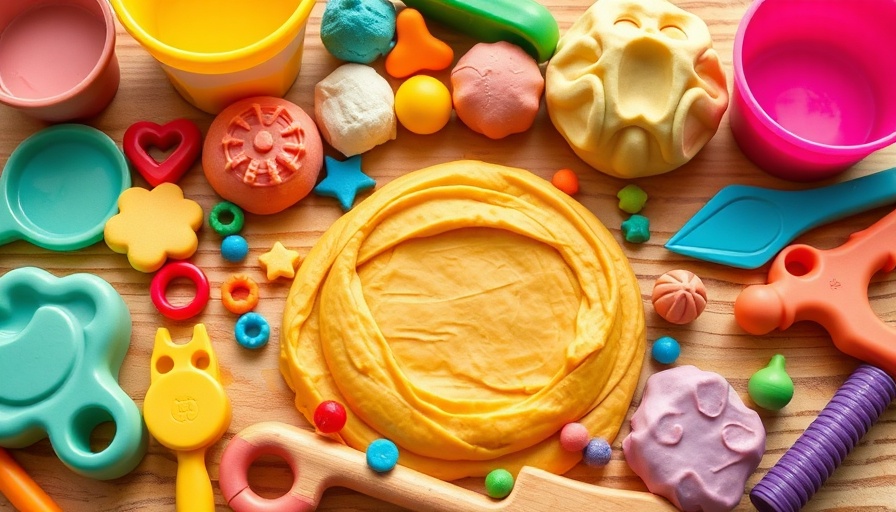
Unlocking Creativity with Playdough: A Gateway to Learning
Playdough is more than just a fun, squishy substance for children. It's a powerful tool that supports various aspects of child development, including fine motor skills, creativity, and sensory exploration. The simple act of rolling, squeezing, and molding playdough comes with significant educational benefits that parents and educators should not overlook.
The Developmental Benefits of Playdough Activities
When children interact with playdough, they engage in a multi-sensory experience that is crucial for their cognitive and physical development. For instance, manipulating playdough strengthens small muscles in their hands, which is essential for tasks like holding a pencil or using scissors later in life.
Studies show that playdough activities can enhance bilateral coordination, where both sides of the body work together to complete a task. Such coordination becomes crucial in literacy skills as children learn to cross the 'midline'—a crucial skill that plays a role in coordinated body movements.
Ages and Stages: Tailoring Activities to Different Developmental Needs
Understanding that every child develops at their own pace is key when introducing playdough activities. Here’s a rough guideline for suitable activities based on age groups:
- Ages 1-2: Simple squishing and sensory exploration activities are best. Use minimal tools to ensure safety.
- Ages 2-3: Children can start making shapes and simple figures, which bolster their fine motor skills.
- Ages 3-4: Engage them in more complex tasks, like creating characters from their favorite stories or even simple math activities, such as counting dough shapes.
- Ages 4+: Kids can now take the lead, combining and creating more elaborate sculptures or designs.
Essential Tools for Playdough Fun
To make the most out of playdough activities, consider these essential tools:
- Playdough: You can use store-bought options or whip up a batch of homemade dough, allowing for customization in color and scent.
- Rolling Pin: An excellent tool for flattening out the dough to make it easier for smaller hands to work with.
- Cutters and Stamps: Cookie cutters and stamps can help children create interesting shapes and bring their imaginations to life.
- Plastic Knives and Scissors: They’re handy for cutting and shaping the dough, aiding in fine motor skill development.
Inspiring Playdough Activities
Here are some engaging playdough activities you can easily set up:
Dino Play-dough Match Activity
All you need are some toy dinosaurs and playdough. Flatten the dough and let your child stamp the dinosaur figures into it. This simple activity promotes matching skills and is visually stimulating.
DIY Play-dough Stamps
Create custom stamps using cardboard and hot glue. Your children will love watching their creations take shape with unique designs!
Making Playdough Pizzas
Have your children flatten the dough to create a pizza base, adding various toppings like dried pasta or beads. This task not only encourages creativity but integrates math skills as they count the toppings.
Using Playdough for Emotional and Social Learning
Playdough can also be an excellent medium for teaching emotions and improving communication skills. Activities that involve storytelling or character creations can help children articulate their emotions and understand the feelings of others.
For instance, after reading a book, ask your child to recreate a character using playdough. This not only fosters creativity but provides a platform for discussions about emotions depicted in their creations.
Future Trends in Educational Playdough Activities
The world of playdough is constantly evolving, and parents can expect more innovative, educational products that integrate technology. From augmented reality playdough kits to apps that guide children through interactive play scenarios, the future looks promising for combining technology with physical play.
Common Misconceptions About Playdough
Some parents believe that playdough is merely a distracting toy with no real educational value. However, as outlined, the developmental benefits of playdough activities are remarkable. By engaging in these creative endeavors, children are building foundational skills that will serve them throughout their educational journey.
Conclusion
Incorporating playdough into playtime opens a world of limitless possibilities for creativity and learning. Gather your tools, roll up your sleeves, and dive into a colorful adventure where play and education go hand in hand. Encourage your children to explore, create, and express themselves with playdough, laying a foundation for skills they'll use for a lifetime!
 Add Row
Add Row  Add
Add 




 Add Row
Add Row 

 Add
Add
Write A Comment